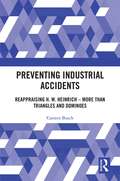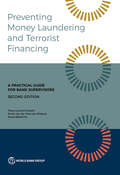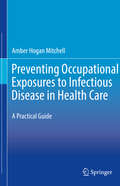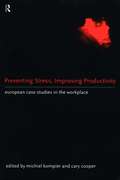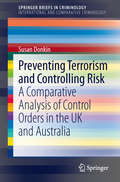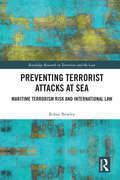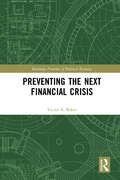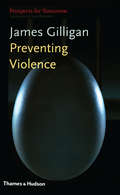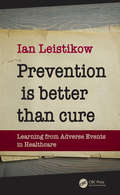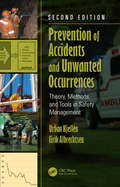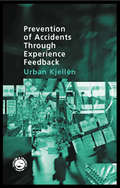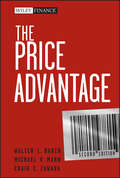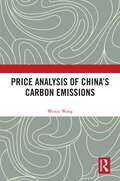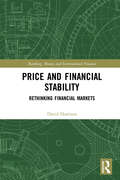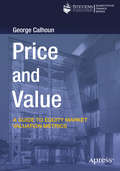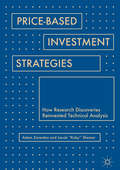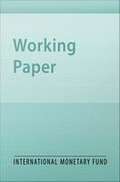- Table View
- List View
Preventing Ideological Violence
by P. Daniel Silk Basia Spalek Mary O’raweThis book presents the voices of police and community members who have been involved in engagement and partnership projects designed for countering violent extremism. Though the threat of the so-called Islamic State garners a great deal of current attention, the book explores ideological violence prevention efforts in a number of contexts, to include that of paramilitary organizations as well as Qa'ida inspired actors.
Preventing Industrial Accidents: Reappraising H. W. Heinrich – More than Triangles and Dominoes
by Carsten BuschHerbert William Heinrich has been one of the most influential safety pioneers. His work from the 1930s/1940s affects much of what is done in safety today – for better and worse. Heinrich’s work is debated and heavily critiqued by some, while others defend it with zeal. Interestingly, few people who discuss the ideas have ever read his work or looked into its backgrounds; most do so based on hearsay, secondary sources, or mere opinion. One reason for this is that Heinrich’s work has been out of print for decades: it is notoriously hard to find, and quality biographical information is hard to get. Based on some serious "safety archaeology," which provided access to many of Heinrich’s original papers, books, and rather rich biographical information, this book aims to fill this gap. It deals with the life and work of Heinrich, the context he worked in, and his influences and legacy. The book defines the main themes in Heinrich’s work and discusses them, paying attention to their origins, the developments that came from them, interpretations and attributions, and the critiques that they may have attracted over the years. This includes such well-known ideas and metaphor as the accident triangle, the accident sequence (dominoes), the hidden cost of accidents, the human element, and management responsibility. This book is the first to deal with the work and legacy of Heinrich as a whole, based on a unique richness of material and approaching the matter from several (new) angles. It also reflects on Heinrich’s relevance for today’s safety science and practice.
Preventing Medical Device Recalls
by Dev RahejaA critical and often overlooked aspect of preventing medical device recalls is the ability to implement systems thinking. Although systems thinking won‘t prevent every mistake, it remains one of the most effective tools for evaluating hidden risks and discovering robust solutions for eliminating those risks.Based on the author‘s extensive experienc
Preventing Money Laundering and Terrorist Financing, Second Edition: A Practical Guide for Bank Supervisors
by Pierre-Laurent Chatain Emile van der Does de Willebois Maud BökkerinkMoney laundering and terrorist financing undermine the integrity and stability of financial systems and can have a significantly adverse impact on a jurisdiction's economy. Challenges to effective supervision and prevention of money laundering and financing of terrorism were exacerbated in the aftermath of the 2008 financial crisis, with financial institutions' need for funds at times undermining vigilance as to the provenance of those funds. As such, supervisors often, and prudently, focused on coping with the crisis. Since 2009, when the first edition of this handbook was published, challenges to the integrity and stability of financial systems have continued to evolve. Money-laundering and terrorist-financing risks continue to threaten the reputations of financial institutions and entire financial sectors, exposing institutions to the possibility of severe enforcement action by public authorities or the loss of correspondent relationship facilities by their private sector counterparts. This second edition reflects the evolving challenges to the integrity and stability of financial systems, recent trends in enforcement actions by country authorities, and changes to international standards, notably an emphasis on a risk-based approach. This practical handbook supports the implementation of international standards established by the Financial Action Task Force and other bodies, * Providing examples of money-laundering and terrorist-financing supervisory frameworks in a range of countries; * Describing best practices for the supervision and enforcement of money-laundering and terrorist-financing laws and regulations; * Offering practical advice on how a particular jurisdiction might incorporate enforcement of the laws and regulations on money laundering and terrorist financing into its supervisory framework. Designed specifically for bank supervisors, this guide will also be of interest to readers working in the areas of finance, corruption prevention, law, accounting, and corporate governance.
Preventing Occupational Exposures to Infectious Disease in Health Care: A Practical Guide
by Amber Hogan MitchellThis book is a practical guide for preventing occupational exposures to bloodborne and infectious disease in health care. It is a timely and essential resource given that people working in healthcare settings sustain a higher incidence of occupational illness than any other industry sector, and at the time of publication of this book we are in the midst of a global pandemic of COVID-19. While the guide is focused on health care primarily, it would be useful for preventing exposures to essential workers in many other industries as well.The guide offers easy-to-follow instruction, all in one place, for creating, implementing, and evaluating occupational health and safety programs. Readers have practical information that they can use now to either build a new program or expand an existing one that protects workers from occupationally associated illness and infection. With a focus on the public health significance of building better, safer programs in health care, the book provides not just the evidence-based or data-driven reasoning behind building successful programs, but also includes sample programs, plans, checklists, campaigns, and record-keeping and surveillance tools. Topics explored among the chapters include: • Occupational Safety and Health Administration (OSHA) Regulatory Compliance • Other Regulatory Requirements, National Standards, and Accreditation • Performing a Hazard Assessment and Building an Exposure Control Plan • Engineering Controls and Safer Medical Devices • Personal Protective Equipment Placement and Use • Facing a Modern PandemicPreventing Occupational Exposures to Infectious Disease in Health Care is a comprehensive resource for both seasoned and novice professionals with primary, secondary, or ancillary responsibility for occupational or employee health and safety, infection prevention, risk management, or environmental health and safety in a variety of healthcare or patient care settings. It also would appeal to those working in public health, nursing, medical, or clinical technical trades with an interest in infection prevention and control and/or occupational health and infectious disease.
Preventing Regulatory Capture
by Daniel Carpenter David A. MossWhen regulations (or lack thereof) seem to detract from the common good, critics often point to regulatory capture as a culprit. In some academic and policy circles it seems to have assumed the status of an immutable law. Yet for all the ink spilled describing and decrying capture, the concept remains difficult to nail down in practice. Is capture truly as powerful and unpreventable as the informed consensus seems to suggest? This edited volume brings together seventeen scholars from across the social sciences to address this question. Their work shows that capture is often misdiagnosed and may in fact be preventable and manageable. Focusing on the goal of prevention, the volume advances a more rigorous and empirical standard for diagnosing and measuring capture, paving the way for new lines of academic inquiry and more precise and nuanced reform.
Preventing Stress, Improving Productivity: European Case-Studies in the Workplace
by Cary Cooper Michiel KompierIn a representative study made of European workers, twenty-eight per cent of employees reported that stress affects their health and their performance at work. Occupational stress is a serious problem for the performance of individuals, organisations and as a consequence, for national economies. Preventing Stress, Improving Productivity investigates the ways in which companies can combat stress by changing the working environment rather than only treating individual employees with stress symptoms.Costs and benefits of stress prevention are discussed, with an emphasis on appraoches that involve both the work situation and the individual worker. The heart of the book consists of eleven European country chapters, each overviewing the current status with respect to occupational stress and its prevention in that country and then presenting one detailed case study an example of good preventive practice. Preventing Stress, Improving Productivity identifies five factors that are critical for a stress reduction programme to work, both in terms of employee health and well-being and from a financial point of view. Successful strategies combine participation from workers and support from top management. Useful as a reference for psychologists, human resource managers, occupational physicians, ergonomists and consultants, this book will also be an invaluable aid to managers in the day-to-day running of organisations.
Preventing Terrorism and Controlling Risk
by Susan DonkinThis Brief takes a provocative look at existing socio-legal literature with a comparative study of terrorism control orders, focusing on how the concept of pre-emption fits within a traditional criminological framework. This timely work examines how such measures might be conceived and interpreted within a situational crime prevention approach. Over the past decade, socio-legal scholars have identified a rise in pre-emptive control mechanisms to respond to terrorism and other threats in the post-9/11 world. Many have argued that this pre-emptive rationale has been used to justify the introduction of measures that transcend established legal and risk frameworks, to deal with individuals or groups thought to pose a threat to the state or its citizens. Preventing Terrorism and Controlling Risk: A Comparative Analysis of Control Orders in the UK and Australia will be of interest to researchers in Criminology and Criminal Justice, particularly with a focus on terrorism, risk assessment, and human rights.
Preventing Terrorist Attacks at Sea: Maritime Terrorism Risk and International Law (Routledge Research in Terrorism and the Law)
by Robin BowleyOver recent decades, it has been widely recognised that terrorist attacks at sea could result in major casualties and cause significant disruptions to the free flow of international shipping. After discussing the overlaps and distinctions between piracy and maritime terrorism, this book considers how the International Ship and Port Facility Security Code, and other vessel identification and tracking measures in the 1974 International Convention for the Safety of Life at Sea, would be likely to reduce the risk of terrorist attacks at sea. It explains how the 1982 United Nations Convention on the Law of the Sea is less than clear on the powers of states to protect offshore installations, submarine cables and pipelines from interference by terrorists. In light of these uncertainties, it considers how the 2005 Protocol to the Convention for the Suppression of Unlawful Acts Against Maritime Navigation, the doctrine of necessity and states’ inherent self-defence rights might apply in the maritime security context. A significant contribution of the book is the formulation of the Maritime Terrorism Threat Matrix, which provides a structured framework for examining how maritime terrorism incidents have occurred, and might occur in the future. The book also examines the relevant national maritime security legislation for preventing maritime terrorist attacks in the United Kingdom and in Australia. The book concludes by formulating guidelines for the unilateral interdiction of suspected terrorist vessels in exceptional circumstances, and recommending priorities for governments and international maritime industries to focus on in order to reduce the risk for terrorist attacks at sea. It will be of interest to those working in the areas of Law and Terrorism, Law of the Sea, Maritime Law and Insurance and International Law.
Preventing the Next Financial Crisis (Routledge Frontiers of Political Economy)
by Victor A. BekerThe collapse of Lehman Brothers, the oldest and fourth-largest US investment bank, in September 2008 precipitated the global financial crisis. This deepened the contraction in economic activity that had already started in December 2007 and has become known as the Great Recession. Following a sluggish and uneven period of recovery, levels of private debt have recently been on the rise again making another financial crisis almost inevitable. This book answers the key question: can anything be done to prevent a new financial crisis or minimize its impact? The book opens with an analysis of the main elements responsible for the 2007/2009 financial crisis and assesses the extent to which they are still present in today´s financial system. The responses to the financial crises - particularly the Dodd-Frank Act, the establishment of the Financial Stability Board, and attempts to regulate shadow banking – are evaluated for their effectiveness. It is found that there is a high risk of a new bubble developing, there remains a lack of transparency in the financial industry, and risk-taking continues to be incentivised among bankers and investors. Proposals are put forward to ameliorate the risks, arguing for the need for an international lender of last resort, recalling Keynes’ idea for an International Clearing Union. This book will be of significant interest to scholars and students of financial crises, financial stability, and alternative approaches to finance and economics.
Preventing the Premature Death of Relationship Marketing
by Susan Fournier David Glen Mick Susan DobschaAs companies develop more and better ways to understand and respond to their customers' needs, relationship marketing has become the talk of the marketing community. Executives, academics, and consultants alike have the same goal in mind--creating meaningful relationships with consumers that will yield both the cost-saving benefits of customer retention economics and the revenue-generating rewards of customer loyalty. Unfortunately, a close look at consumers suggests that these relationships are troubled ones at best. The things that marketers are doing to build relationships with customers, are, in fact, subverting them. Relationship marketing--what is supposed to be the acme of customer orientation--is falling far short of its mark. Susan Fournier, assistant professor at the Harvard Business School, Susan Dobscha of Bentley College in Waltham, MA, and David Glen Mick, a professor at the University of Wisconsin offer a way to get this concept back on track.
Preventing Violence (Prospects for Tomorrow)
by James GilliganIn this controversial and compassionate book, the distinguished psychiatrist James Gilligan proposes a radically new way of thinking about violence and how to prevent it. Violence is most often addressed in moral and legal terms: "How evil is this action, and how much punishment does it deserve?" Unfortunately, this way of thinking, the basis for our legal and political institutions, does nothing to shed light on the causes of violence. Violent criminals have been Gilligan's teachers, and he has been their student. Prisons are microcosms of the societies in which they exist, and by examining them in detail, we can learn about society as a whole. Gilligan suggests treating violence as a public health problem. He advocates initiating radical social and economic change to attack the root causes of violence, focusing on those at increased risk of becoming violent, and dealing with those who are already violent as if they were in quarantine rather than in constraint for their punishment and for society's revenge. The twentieth century was steeped in violence. If we attempt to understand the violence of individuals, we may come to prevent the collective violence that threatens our future far more than all the individual crimes put together.
Preventing War: The United Nations and Macedonia
by Abiodun WilliamsDescribes the role the UN played in Macedonia.
Prevention is Better than Cure: Learning from Adverse Events in Healthcare
by Ian LeistikowAdverse events occur in healthcare with worrying and surprising frequency and, of these, a substantial portion are preventable. This highly-readable book, translated and update from the original Dutch edition, presents 15 model case studies which have been carefully designed to explore common themes in medical errors and offer learnings from those events that will guide practice to prevent similar tragedies unfolding in future. Using 15 years of experience working in patient safety, the author makes concrete recommendations around assessment, attitude and performance, and provides a concise and accessible methodology for working safely.
Prevention of Accidents and Unwanted Occurrences: Theory, Methods, and Tools in Safety Management, Second Edition
by Urban Kjellen Eirik AlbrechtsenThis new edition comes after about 15 years of development in the field of safety science and practice. The book addresses the question of how to improve risk assessments, investigations, and organizational learning inside companies in order to prevent unwanted occurrences. The book helps the reader in analyzing the subject from different scientific perspectives to demonstrate how they contribute to an overall understanding. It also gives a comprehensive overview of different methods and tools for use in safety practice and helps the reader in analyzing their scope, merits, and shortcomings. The book raises a number of critical issues to be addressed in the improvement process.
Prevention of Accidents Through Experience Feedback
by Urban KjellenProviding a practical introduction to the basic theories and principals of accident prevention through diagnosis and feedback control, this book presents the various methods and tools of safety, health, and environment (SHE) practice where experience feedback is employed. These include methods of accident and near accident reporting and investigati
PRG-Schultz International
by Paul W. Marshall James WeberPRG-Schultz will run out of cash within a couple of months unless the new CEO can reduce costs and restructure the company's debt. PRG was the dominant market leader in the audit recovery industry. The industry consisted of firms which employed accounting professionals to audit purchasing transactions to discover and collect funds owed to their clients. PRG had historically been profitable, and clients were satisfied with their service. In recent years, however, the industry overall and PRG's sales, had been in decline. This left PRG with a cost base that was no longer sustainable. The CEO must decide where to cut costs and how to convince creditors to give the company the time it needs to turn around. A bankruptcy reorganization is one option open to the company. Describes the audit recovery industry, the company's history, the CEO, the financial problems the company faced, and the first steps taken by the CEO to save the company.
The Price Advantage
by Baker Walter L. Marn Michael V. Zawada Craig C.A comprehensive look at creating pricing strategies that work in both good economic times and bad Written by three preeminent pricing experts at McKinsey & Company, the Second Edition of The Price Advantage is a practical pricing guide for the executive or pricing practitioner who wants to identify, capture, and sustain substantial pricing gains in their business. Pricing is by far the most powerful profit lever that managers can influence. Yet few companies approach pricing in a way that fully capitalizes on its value. This Second Edition, a major revision and extension of the first book, shows you what it takes to achieve the price advantage in today's competitive and complex business environments. Based on in-depth, first-hand experience with thousands of companies, this book provides managers with a pragmatic guide through the maze of pricing issues. It reinforces why pricing excellence is more critical than ever today and then explains state-of-the-art approaches to analyzing and improving your own pricing strategy and execution. Explores the fundamental role of pricing infrastructure in achieving the price advantage Includes new topics such as software and information products pricing, lifecycle pricing, custom-configured products pricing, pricing of high-count product lines, pricing in distributed sales environments, "razor/razor blades" pricing, and tiered products and services pricing Revisits the full range of classic McKinsey pricing tools, including the pocket price waterfall and value maps Engaging and informative, the Second Edition of The Price Advantage will put this essential discipline in perspective.
Price Analysis of China's Carbon Emissions
by Wenju WangThis book explores the determination of China’s carbon emission targets, especially with regard to the allocation of responsibility of China’s import and export carbon emissions, and carbon emission quota allocations across different time periods, industries, and regions.Research outside of China tends to focus on methods and approaches of carbon emission reduction policies and the impact of their implementation. Instead, within China, the focus has been on discussion of the necessity and conditions for China's development of a low-carbon economy as well as its introduction as a concept in the light of overseas comparisons. This book utilizes game theory, mechanism design, input-output theory, econometric theory and other methods to scrutinize China's carbon emissions and carbon emissions targets across different periods, industries, and regions. The result is a detailed theoretical and empirical investigation of carbon emission issues in the Chinese context. The book will be essential reading for students and scholars of economics, especially those with a focus on Chinese economic development and policymakers in the low-carbon economy sphere.
Price and Financial Stability: Rethinking Financial Markets (Banking, Money and International Finance)
by David HarrisonWhy are financial prices so much more crisis-prone and unstable than real economy prices? Because they are doing different things. Unlike real economy prices, rooted in the real goods and services produced and exchanged, financial prices attempt to value future income flows from financial and capital assets. These valuations fluctuate erratically because expectations of the future fluctuate – and large liquid financial markets can amplify, rather than correct, these effects. The book builds on the insights of economists Frank Knight and John Maynard Keynes, that uncertainty of the future is essential to understand the processes of economic production and capital investment, and adds to this Karl Popper's general explanation of how expectations of an uncertain future are formed and tested through a trial and error process. Rather than relying on fluctuating financial prices to provide a guide to an uncertain future, it suggests a better approach would be to adopt the methods common to other branches of science, and create testable (falsifiable) theories allowing reasonable predictions to be made. In finance, the elements of one such theory could be based on the concept of forecasting yield from capital assets, which is a measurable phenomenon tending towards aggregate and long-term stability, and where there is a plentiful supply of historic data. By methods like this, financial economics could become a branch of science like any other. To buttress this approach, the widely accepted public policy objective of promoting real economy price stability could be widened to include financial price stability.
Price and Prize of Leadership: Being a More Effective Leader
by Rob Goffee Gareth JonesLeadership is complicated, and the secrets of great leadership resist simple recipes. The fact is that leadership is a risky occupation. This chapter revisits some important strategies for achieving authentic leadership, assuring leaders that whatever the price of taking risks, the prize is worth it.
Price and Value: A Guide to Equity Market Valuation Metrics
by George CalhounUnderstand how to use equity market metrics such as the price/earnings ratio (and other multiples) to value public and private enterprises. This essential book gives you the tools you need to identify and qualify investments and assess business strategy and performance. Author George Calhoun, Founding Director of the Quantitative Finance Program at Stevens Institute of Technology, shows you how to use metrics to appraise mergers, acquisitions, and spin-offs. You will be able to shed light on financial market conditions, benchmark fair value assessments, and check and calibrate complex cash flow models. Market multiples share a peculiar construction: they are based on an explicit apples-to-oranges comparison of market prices with accounting fundamentals, combining data derived from two very different sources and methodologies. This creates ambiguities in interpretation that can complicate the application of these metrics for the many purposes. Multiples are thus easy to construct, but they can be difficult to interpret. The meanings of certain multiples have evolved over time, and new-and-improved versions have been introduced. The field is becoming more complex and the question of which metrics perform best can be a source of controversy.What You Will Learn Know the definitions, interpretations, and applications of all major market ratios, including: price/earnings (trailing and forward), cyclically adjusted price/earnings, cash-adjusted price/earnings, EV/EBITDA, price/sales, dividend yield, and many moreExamine the factors that drive the values of ratios from firm level (such as earnings growth, leverage, and governance) to market level (such as inflation, tax and fiscal policy, monetary policy, and international characteristics)Apply metrics in: investment analysis, index construction, factor models, sum-of-the-parts analysis of corporate structures, and detection of asset bubblesWho This Book Is For Professionals at all levels working in the finance industry, especially in fields related to investment management, trading, and investment banking who are involved with valuation and assessing and advising on corporate transactions and interpreting market trends, and university students in finance-related programs at the undergraduate and graduate levels
Price-Based Investment Strategies: How Research Discoveries Reinvented Technical Analysis
by Adam Zaremba Jacob Koby" ShemerThis compelling book examines the price-based revolution in investing, showing how research over recent decades has reinvented technical analysis. The authors discuss the major groups of price-based strategies, considering their theoretical motivation, individual and combined implementation, and back-tested results when applied to investment across country stock markets. Containing a comprehensive sample of performance data, taken from 24 major developed markets around the world and ranging over the last 25 years, the authors construct practical portfolios and display their performance—ensuring the book is not only academically rigorous, but practically applicable too. This is a highly useful volume that will be of relevance to researchers and students working in the field of price-based investing, as well as individual investors, fund pickers, market analysts, fund managers, pension fund consultants, hedge fund portfolio managers, endowment chief investment officers, futures traders, and family office investors.
Price Discrimination
by Anirudh DhebarThis note, which is introductory in nature, provides a classification scheme for some of the more common examples of price discrimination. For each case that is discussed, the note characterizes the appropriate market segments, the alternative product "versions," and the differences in the firm's economics from one version to another.
Price Dynamics in the Eastern Caribbean
by Yan Sun Rupa DuttaguptaA report from the International Monetary Fund.

